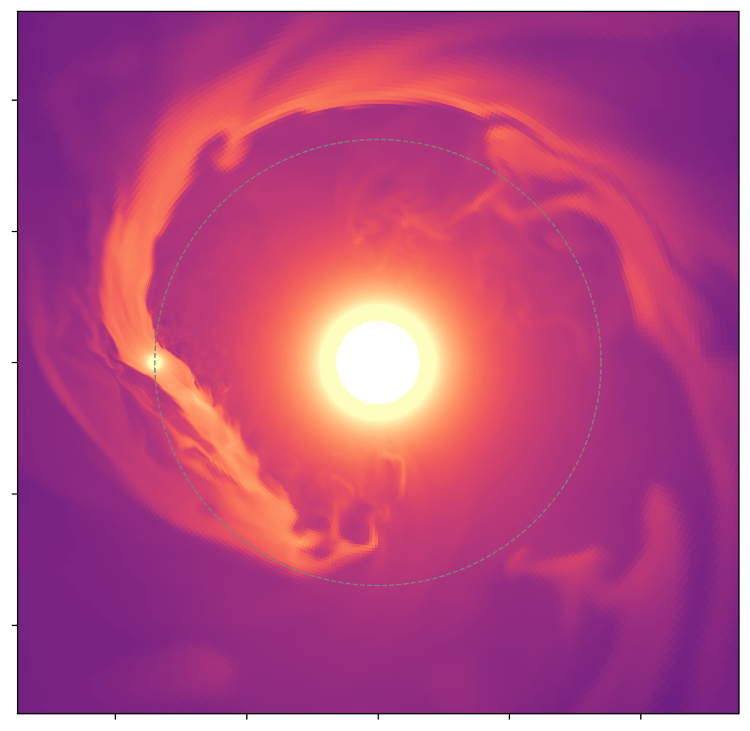In a recent study published in Science Advances, a team of researchers commissioned the Hobby-Eberly Telescope (HET) , which is designed to study exoplanetary atmospheres, to examine how a “hot Jupiter” exoplanet is losing its helium atmosphere as it orbits its parent star, leaving tails of helium that extend approximately 25 times the diameter of the planet itself. The exoplanet, HAT-P-32 b , is located approximately 950 light-years from Earth with a diameter of almost four Jupiters, a mass of 0. 68 Jupiters, and orbiting an F-type star slightly larger than our Sun.
This study holds the potential to help scientists not only better understand how HAT-P-32 b is losing its atmosphere but could also offer insights into both the formation and evolutionary processes of exoplanets and their atmospheres, as well. “It is exciting to see how gigantic the extended tails are compared to the size of the planet and its host star,” said Dr. Zhoujian Zhang , who is a NASA Sagan fellow at the University of California, Santa Cruz, and lead author of the study.
Remove All Ads on Universe Today Join our Patreon for as little as $3! Get the ad-free experience for life As noted, HAT-P-32 b is known as a “hot Jupiter” , which is a class of exoplanets characterized as being between 0. 36 to 11. 8 Jupiter masses and orbital periods between 1.
3 to 111 days. HAT-P-32 b fits these characteristics as denoted by its 0. 68 Jupiter masses and an orbital period of 2.
2 days. For context, the planet Mercury has an orbital period of 88 days, meaning “hot Jupiters” have the potential to orbit much closer to their parent star than Mercury does to our Sun, as is the case with HAT-P-32 b. For the study, the researchers used a combination of HET’s Habitable-zone Planet Finder Spectrograph and the “transit method” to analyze the atmospheric composition of HAT-P-32 b throughout one complete orbit, which is only 2.
2 days. The transit method has primarily been used to discover exoplanets from the dimming of starlight as the planet passes in front of its parent star, and can be viewed in our own solar system as Venus has been observed from Earth to transit our own Sun. However, the transit method is also useful for analyzing a planet’s atmosphere with spectroscopy , which uses light to analyze a planetary atmosphere’s elemental composition.
In this case, the helium gas escaping from HAT-P-32 b’s atmosphere. Previous studies have made partial observations of HAT-P-32b’s helium tail by observing partial orbits when the planet transited its parent star, but this is the first study to observe one complete orbit of HAT-P32 b. “We would not have seen this without the long-timeframe observations that we can get with the Hobby-Eberly Telescope,” said Dr.
Caroline Morley, who is an assistant professor in the Department of Astronomy at The University of Texas at Austin, principal investigator for the HET Exospheres Project, and a co-author on the study. “It allowed us to observe this planet for its full orbit. ” While the data collected from the observations encompassed one complete orbit, the researchers had to conduct several observations in August, September, and October 2020, as well as what are known as out-of-transit periods that occurred two days before and after each transit.
When combined, all the data measured one full orbit, along with the team also monitoring the parent star’s solar activity between August 2020 and December 2020, as well. The study’s findings determined the helium tail’s length is 53 times the radius of HAT-P-32 b, which is also equal to approximately seven times the radius of its parent star. The team then compared their observations with computer models called three-dimensional (3D) hydrodynamic simulations and determined the parent star’s temperature—~5700 degrees Celsius (~10,200 degrees Fahrenheit) compared to our Sun at ~5500 degrees Celsius (~9900 degrees Fahrenheit)—combined with the 2.
2-day orbit is responsible for producing the HAT-P-32 b’s helium tail from gas expansion. The 3D modeling was led by study co-author, Dr. Morgan MacLeod, who is a postdoctoral fellow at the Harvard-Smithsonian Center for Astrophysics.
He recently held a short Q&A session with the University of Texas at Austin (UT Austin) press regarding the modeling aspect of the study, and gave Universe Today permission to re-print his insight: “In astronomy, to understand what we’ve seen, we have to try to recreate it with computer models—this is as close as we can get to doing experiments in a laboratory,” Dr. MacLeod told UT Austin. “I created simulations of the gas dynamics of planetary material being evaporated from HAT-P-32b.
We used these models to interpret the observation of extra absorption of stellar light well outside the transit of the planet. What we realized is that the gravity of the star stretches the outflowing planetary material into long tails that trace ahead of and behind the planet in its orbit. ” The study’s findings note the massive size of the helium tail could indicate the gas expansion has caused some of the gas to escape the gravitational pull of the planet, with the parent star now pulling the gas into its own orbit.
The study notes this massive helium tail as being “among the largest structures ever observed in a planetary system”. “Our findings on HAT-P-32b may help us understand how other planets and their stars interact,” said Dr. Morley.
“We are able to take high-precision measurements on hot Jupiters, like this one, and then apply our findings to a wider range of planets. ” Those planets include WASP-69 b and WASP-107 b , which also exhibit helium tails, though not as pronounced as HAT-P-32 b. What new discoveries will scientists make about exoplanetary atmospheres and “hot Jupiters” in the coming years and decades? Only time will tell, and this is why we science! As always, keep doing science & keep looking up!.
From: universetoday
URL: https://www.universetoday.com/161967/this-hot-jupiter-is-leaving-a-swirling-tail-of-helium-in-its-wake/



